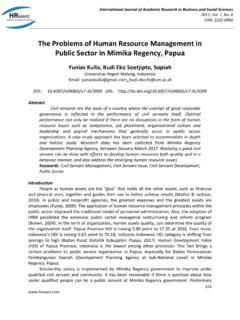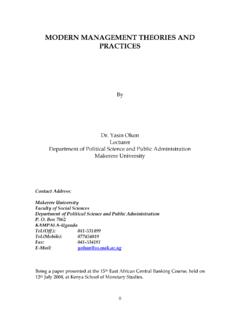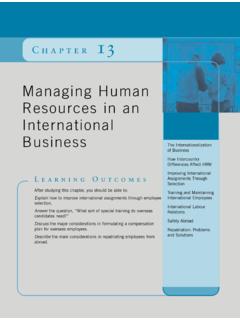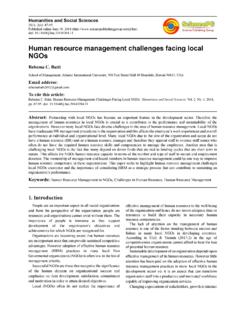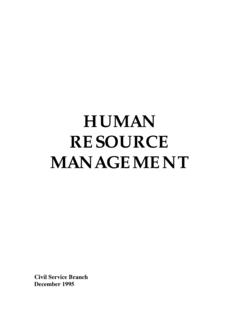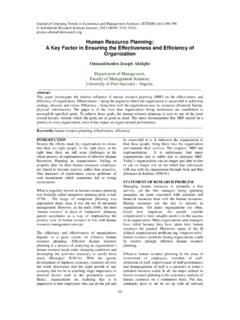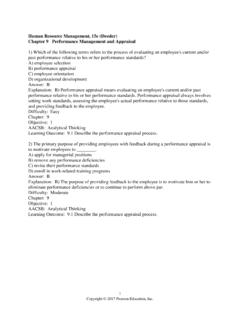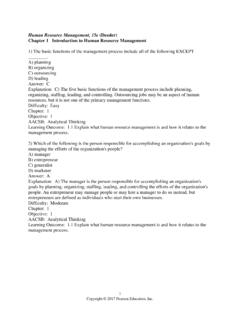Transcription of Problems and Challenges in Human Resource …
1 Pakistan Journal of Commerce and Social Sciences 2008 37 Problems and Challenges in Human Resource management : A Case of Large Organization in Pakistan Ali Irshad MBA, management Associate (Trading Credit Risk management ), OCBC Bank, Singapore E-mail: SHAMAS-UR-REHMAN TOOR (Corresponding Author) PhD Candidate and Research Scholar Department of Building, Faculty of Design and Environment, National University of Singapore, Singapore E-mail: Abstract This paper critically analyzes the work culture for a mainstream financial organization operating within Pakistan, while drawing a specific example to elucidate certain dilemmas that impede the potential growth for the financial sector and its constituent workforce, besides hampering the performance of the organizations.
2 The case study is related to an organization in financial sector which conducts a management Trainee Program with the purpose to select, train and develop a high-potential pool of talent into future leaders and fore-runners of the organization. This paper critically analyzes several inherent Problems that face the successful implementation of the trainee program under the frameworks of various theories of organizational management . To solve these Problems , this article presents a detailed diagnosis of the management shortcomings to improve the firm s corporate culture, work ethics and employee handling strategy and mechanism. Recommendations are also made to minimize the Problems and maximize the success of the management Trainee Program in the case study organization.
3 Keywords: Human Resource management , management trainee program, Problems , Challenges , motivation. 1. Introduction There is growing evidence that Human resources are crucial to organizational success, and may offer the best return on investment for sustainable competitive advantage (Luthans and Yousef, 2004). Therefore, in this paper, the authors argue that the organizations in financial sector should adopt Human Resource management (HRM) at strategic level and benefit from emergent approaches of HRM to attract, retain, develop, and motivate the talent. Significant research in domain of Human Resource management focuses on attracting, motivating, and retaining the knowledge worker (see: Horwitz et al., 2003; Horwitz et al., 2006; Baron et al.)
4 , 2001; Evans et al., 2002). So-called best practices of attractive job design, high pay-offs, paid holidays, skill enhancement programs, increased autonomy, and flexible work hours are used by the employers to attract the experienced as well as young professionals to work for them (Olson, 2003; Stovel and Bontis, 2002). Every firm wants the best people to work for it and makes every effort to maximize their performance. To get the best people, organizations often pull staff from their competitors by offering them better monetary packages. These factors have resulted in unprecedented job uncertainty. Necessary lay-offs have exacerbated the situation by reducing the organizational loyalty to new lows. Several scholars describe this situation as war-for-talent (Hargie, 2004; Michaels et al.
5 , 2001). A study of McKinsey & Company consultants exposed the war for talent as a strategic business challenge and a critical driver of corporate performance (see Michaels et al., 2001). They found that secret of high-performing companies, as compared the average-performers, was a pervasive talent mindset. They believed in superior talent and its management as their competitive advantage. This is what most average- and low-performing companies struggle with. They are either incapable of attracting the right talent or fail to cherish and leverage it when they incidentally get it. War-for-talent has not only emerged as one of the biggest Challenges of contemporary business world, but fighting and winning over talent to enhance organizational competitive advantage has emerged as core strategy of several fast growing organizations.
6 Pakistan Journal of Commerce and Social Sciences 2008 38 Winning the fierce competition businesses is rather easier through organizational capabilities such as speed, responsiveness, agility, learning capacity, and employee competence. Boudreau and Ramstad (2005) argue that as organizations increasingly compete through talent, their investments in Human capital will determine their competitive positions. In the war-for-talent, successful organizations will be those that are able to quickly turn strategy into action; to manage processes intelligently and efficiently; to maximize employee contribution and commitment; and to create the conditions for seamless change.
7 However, organizations who have not responded to the emerging talent crisis are already suffering from what many scholars now call an impending leadership crisis (see: George, 2003; Toor et al., 2006;). Describing the so called leadership crisis, many scholars as well as practitioners have lamented asking where have all leaders gone? (Bennis, 2005; George and Sims, 2007). Rock (2006) argues that many business organizations lack the right people and adequate talent to take up the leadership positions. This paper presents a case study of an organization that has been unable to manage its Human resources and hence faces many related Problems . It critically analyzes how and why the case study organization failed to integrate their HR policies within their strategic agenda which eventually led to several HR related Problems such as inability to attract, develop, and effectively utilize the talent.
8 Along with the analysis, recommendations are made as to how organizations can better integrate their HR policies as a part of their organizational vision to achieve their objectives. 2. Study Objectives This study has the following objectives: 1. To critically analyzes the work-place culture of an organization in the financial sector 2. To study the Problems related to HRM in depth from a specific perspective of management trainee program 3. To analyze the factors leading these Problems 4. To suggest detailed recommendations to overcome the HRM-related Problems 3. Methodology To address the above objectives, in-depth case study method was adopted. For this purpose, interviews were conducted with 45 management trainees who were recruited under the management trainee program in the case study organization.
9 Interviews were conducted over one year time during May 2005 to May 2006. These interviews were usually informal to ensure that the trainees were at ease to answer the questions and elaborate the real-life situation and Problems in openness. Interviews were also conducted in informal settings during coffee breaks, lunch times, and walk-in appointment with the trainees. A typical interview lasted 15-20 minutes. Notes were taken during the interviews and anonymity was ensured to the interviewees. Interview questions mostly focused on: effectiveness of the management trainee program; Problems that the trainees were facing during the appointment; work-place culture of the organization; potential of the program in terms of intellectual development of the trainees; adequacy of employee-reward system; fulfillment of personal needs; work-life balance; and fulfillment of contractual obligations from the perspective of the organization.
10 In addition to the interviews, secondary data was collected from the documents available within the Organization s database. These documents generally included history of the organization, annual financial reports, monthly news letters and periodicals, reports on management trainee program, values and ethics code, employee handbook, database of employee feedback surveys, performance appraisal matrices and related documents. Details from the secondary documents were then integrated to formulate the case study background which was helpful during the case-analysis stage. The case analysis was performed by a team of researchers comprising 4 members. Details of the analysis were discussed in several meetings to ensure that each interview was discussed in sufficient detail and all secondary documents were adequately analyzed.



